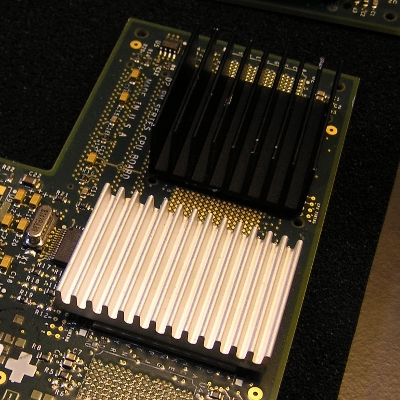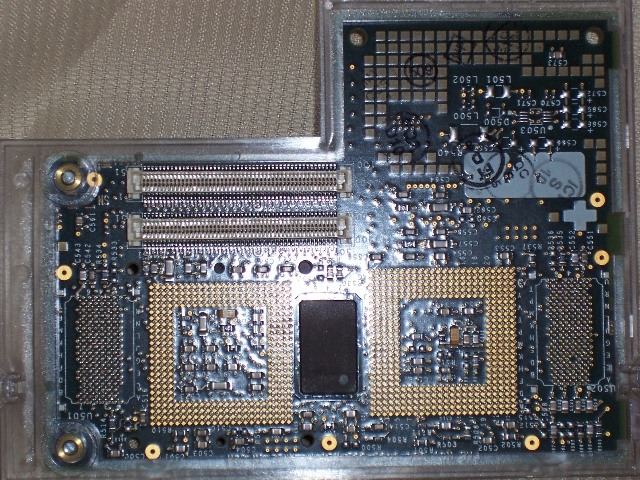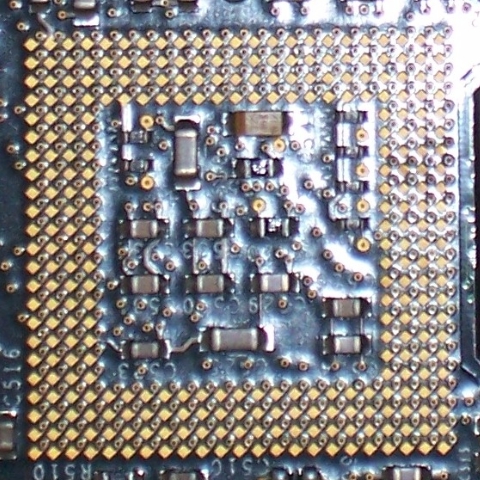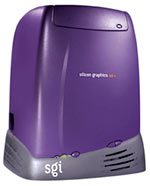
| SGI O2 with a fast, low power CPU?: | ||
|---|---|---|
me, too! But how? |
| |
Now you do seriously want one, too?
First, of course, you have to own a SGI O2, so you have the housing already. If you don´t, just open a new tab on your browser (it does tabbed browsing, doesn´t it?) and get yourself one at ebay. Choose the R5271 variant eventually, i. e. the one that has a HD-BGA 304 CPU and is already well suited for the 600MHz mod. It may be 200 - 350MHz (there were many different versions in existence). Make sure the housing isn´t too much scuffed, scratched or broken. Most collectors prefer the "cubed" version, i. e. with the older, "3D" silver cube logo. But that´s only a matter of taste... personally, I´d very much like to have one labeled O2+ and of indigo colour, not blue, but these seem to be damn rare. Never saw one myself... the one depicted on the main page of this site, y´know. Second, if yours is a R10000 or R12000 one, leave it as it is. A 600 MHz R7000C CPU is said to be not remarkably faster compared to a R12000. Its advantage is that is consumes about only a tenth of the power a R12k takes (if at all), therefore handling its dissipated power is pretty easy: a passive heatsink is sufficient. 
Second, if it is a R5000 CPU you have, check if the CPU module is rectangular. If so, it is a 180MHz CPU which is not pin-compatible with 304BGA. Sorry. Get yourself a suited CPU module first... Since I recently got me some spares I could provide you one. Ask for a quote. Third, if the CPU module is L-shaped, and you count 304 pads below the CPU, (the one beneath the black heatsink) then you´re lucky. 

Your CPU module eventually is a 200MHz (rare), 300MHz or 350MHz one, a R5271 or R7000A (rare again) in a 304 HD-BGA package and pin-compatible with a decent PMC R7000C 600MHz. Next, check out for the L3 cache chips... these are located either beneath or on both sides of the CPU module. Most common are the PCB designs with the little blue patch wire on the voltage regulator. These have two BGA cache chips on either end of it on the CPU side, and the tag RAM - also BGA - is located in the middle of the PCB on the other side. R7000A modules unfortunately often lack the L3 cache. If so, you´ll notice arrays of goldish pads on the PCB in at least 3 different areas. Unfortunately there is no way to get these chips nowadays - these once were exotic and now are long out of production :-(. Please correct me if I´m wrong ;-). If you happen to own some additional 180 MHz R5000 O2 CPU module you are willing to slaughter for the L3 chips alone - go ahead, but be informed that desoldering, reballing and resoldering of these 3 chips may cost much more than it is worth since this is a time-consuming work. Consider a 200-250 Euro charge for the exchange of the L3 cache alone. Btw., a R7000C@600MHz CPU runs fine without L3 cache. I have one without and I yet felt no difference - but that may depend on the application one is running. There are other - improved - PCB designs with no blue patch wire on it. These carry L3 cache in 3 QFP chips, all attached to the bottom of the PCB. If everything else is fine so far, you may notify me about your desire by email. A soon as ten CPU modules can be done in a batch I´ll invite you to send me your CPU. A repair shop nearby will do the tricky part - the HDBGA de- and re-soldering etc., and some x-ray inspection of the invisible solder flow below the CPU Back at my home I re-attach the heat sink and do some more testing in my O2s. When the CPU module passes all diagnostics and flawlessly boots into IRIX I´m done. You will receive your CPU module back, then being a R7000C@600MHz one. | |

|
|
 |